 Various media (like the New York Times) are reporting that the flaw that sent a Soyuz rocket crashing into Siberia last month has been identified. Judging from the telemetry, Russian space agency officials are claiming it was due to a clogged pipe that kept the third-stage motor running. When the pipe stopped feeding kerosene to a turbine, power failed to a fuel pump, and the third stage burn stopped.
Various media (like the New York Times) are reporting that the flaw that sent a Soyuz rocket crashing into Siberia last month has been identified. Judging from the telemetry, Russian space agency officials are claiming it was due to a clogged pipe that kept the third-stage motor running. When the pipe stopped feeding kerosene to a turbine, power failed to a fuel pump, and the third stage burn stopped.
The rocket had supplies destined for the International Space Station. The loss of the supplies is not really the issue, however. A similar rocket is used to bring up astronauts, and until and unless the problem is fixed, it’s too risky to send anyone up. This may mean the ISS will be de-crewed in the next couple of months.
That’s the immediate issue. However, this rocket failure is a bit more problematic. The flaw appears to have happened in the manufacturing process, and that’s the sticky point. If it were something procedural setting up for launch (tanking up the rocket, for example), that’s a relatively easy fix. If it were some malfunction in the machinery used to make the rocket (again, possible to find and fix in general), the flaw would’ve turned up more often. That leaves something that happened by accident, and that’s not terribly reassuring. How do you know when a problem like that is mitigated? What was the exact circumstance that led to the pipe being faulty?
Until the Russians can figure that out, implement a fix, and make sure that problem is eliminated – and that other similar mistakes are prevented – it’s too risky to allow astronauts to fly on board the rocket. And that, currently, is the only way to get humans up to the space station. The only other rocket currently capable of getting up there is the SpaceX Falcon 9, which has not yet proven its reliability, and in any case has not been cleared by NASA to carry humans (the SpaceX Dragon capsule could theoretically do that, but needs to pass a set of strict regulations to be (pardon the expression) street legal).
I’ll note the Wall Street Journal is reporting that with the flaw being found, Soyuz flights could resume as early as October. Interestingly, the WSJ article reports that NASA is optimistic, while the NYT article says the Russian commission that investigated the crash is more cautious. The WSJ also says NASA may have a statement out this week, so we’ll see. I don’t see any mention of this on the NASA site (an ISS telecon will be held on Tuesday, September 20), but I’ll keep my eyes open.
Also note that three of the six astronauts on the ISS will be coming home in a Soyuz capsule on Thursday, September 15th (note the capsules are unrelated to the rocket that failed). They plan to undock and make the de-orbit burn at 03:06 UT Thursday (23:06 Eastern US time Wednesday night) and land in Kazakhstan 04:01 a.m. UT. That will leave three astronauts on the ISS; they will either have to come home to Earth by mid-November due to the limited fuel lifetime of their return capsule, or have a new capsule put in place. And that won’t be possible until flights resume.
This whole thing is still unfolding, so stay tuned – and you should follow Universe Today as well, which tends to have information on these topics up pretty quickly.
Image credit: NASA